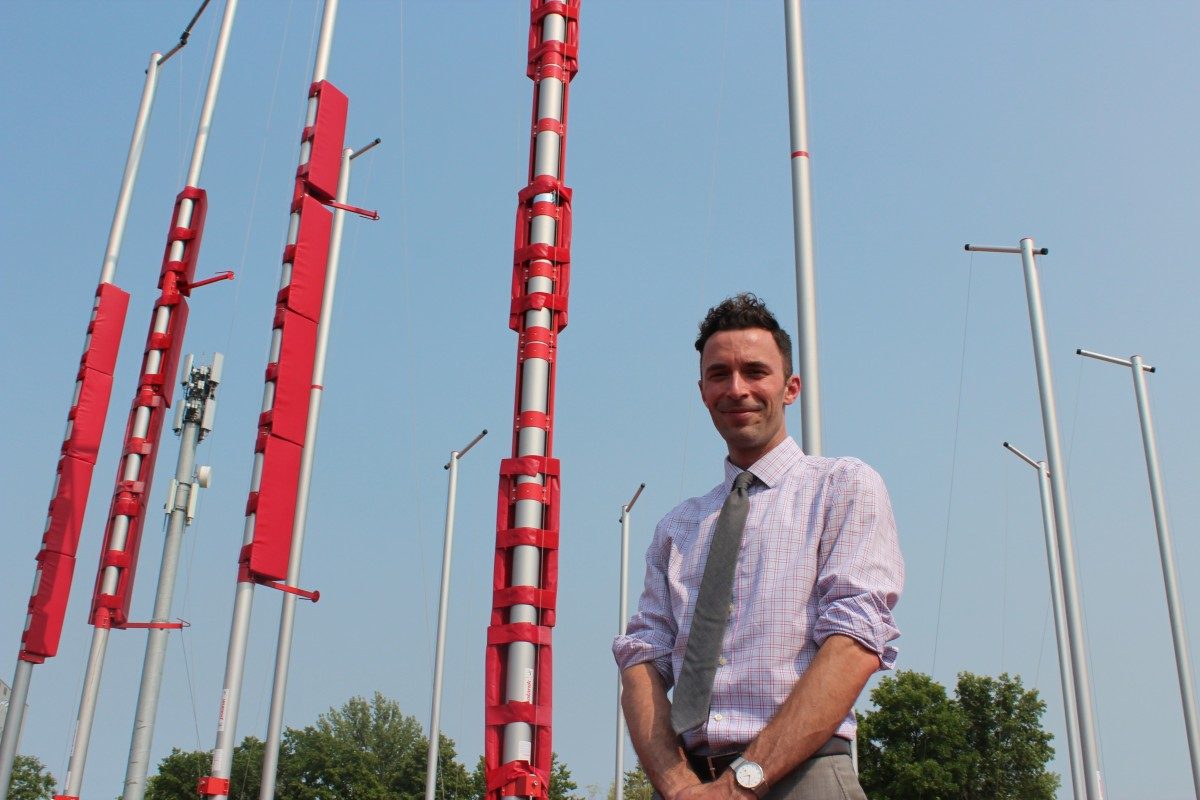
Andrew Lovatt is a U of M alumnus [BEnvD/04] and Architectural Project Manager on campus. // Photo by Chris Reid
Recollections from the Games: Andrew Lovatt
Alumnus Andrew Lovatt talks about his involvement with the Canada Summer Games
The University of Manitoba’s Fort Garry campus has been an active place this summer thanks to the 2017 Canada Games. Athletes donning their provincial team clothing can be seen eating in University Centre, walking along Curry Place Pedway and working out in the Active Living Centre. It’s an exciting time be on our campus.
What happens after the games?
One of the main benefits of hosting the Canada Games is the legacy it leaves in the host city. For the U of M, the Canada Games will leave behind the gift of a brand new track surface at our University Stadium. As the venue for athletics events, the University Stadium received an upgrade both on and off the field of play, including resurfacing of the track and upgrades to the field disciplines competition areas.
Andrew Lovatt is a U of M alumnus [BEnvD/04] and Architectural Project Manager on campus. He played a key role in the U of M stadium track resurfacing project leading up to the 2017 Canada Summer Games. He describes the project and his part in preparing the University Stadium for the games.
Describe your role at the U of M and how your role intersects with hosting the Canada Games on our campus.
As an architectural project manager in Physical Plant, I lead design and construction projects from inception to completion. For the upgrades at University Stadium, I acted as the university’s representative and advocate, tasked with ensuring work met the standards of Physical Plant and also the Faculty of Kinesiology & Recreation Management, which operates the facility.
What was the process in determining that University Stadium would receive the track upgrade for the games?
When Manitoba won the bid to host the 2017 Canada Summer Games, it had already been determined that the athletics events would be held at University Stadium – as it’s the only 8-lane, 400m track in the province. The track surface, last upgraded for the 1999 Pan Am Games, had reached the end of its life and needed to be replaced for the Games.
When did this process start and what was involved?
I became involved in this undertaking in July 2014 – nearly 3 years ago to the day. The major component was the replacement of the track surface, but there were also other upgrades: we built a new 5-lane 100m warm-up track and moved the throws events to within the competition area; doubled the number of jump pits to 4 (which allows 2 simultaneous jump events). All of this work was done to IAAF Class 2 standards. A new photo / timing booth was added on top of the existing grandstand, and there were also some landscaping improvements. Before Investors Group Field was built next door, Bisons Football called University Stadium home, so it was a multi-sport facility. With these upgrades, we’ve dedicated the entire facility to athletics (one of only a few in Canada).
How do you think this upgrade will positively impact the U of M, our Bison athletes and the community?
Bisons athletes and community stakeholders (such as high schools) will benefit from these upgrades greatly when they use the facility for competitions and training – there is a sense of excitement when running on a new track, so expect some fast times in the athletics events. 2017 is truly a great year to be a Bison, as we now have brand new tracks at both our indoor and outdoor facilities.
Do you have any other involvement with the Canada Games this year or in years past?
I was a high jumper in a previous life but never made it (not even close!) to this competitive level. My father (Bob Lovatt) competed in the 1969 Canada Summer Games in Halifax for triple jump and long jump. He held the provincial triple jump record from 1967 to 2016 (49 years!) He competed in University Stadium, so I felt a sense of personal attachment to this project from the beginning.
Is there anything else that you would like to tell us?
2017 is a very significant year. It’s the 50th year for the Canada Games, the 140th year for our university, and the 150th year for our country. To all athletes, coaches, volunteers, and spectators, I hope it’s truly amazing. Thank you to the 2017 Canada Summer Games for making a major investment in our facility that truly leaves a legacy. I’d like to acknowledge the following, who were instrumental in the upgrades – It’s been a fun few years, and I have mixed feelings as these projects draw to a close.
Andrew Lovatt would like to acknowledge the following individuals for their role in the project:
• CSG 2017 Host Society: Bobby McMahon, Janet McMahon
• UM Kinesiology & Recreation Management staff & faculty: Simon Wang, Claude Berube, Ken Snider
• Athletics Manitoba: Donna Harris, Terry Armstrong; Athletics Canada: Jim Murray
• DIALOG (sport architect): Doug Wournell, Jak New; 1×1 Architecture (photo/timing booth): Jason Kun, Kailey Kroeker
• Playteck Enterprises (track installer): Mathieu Auffrey, Chris O’Brien; Beynon Sports Surfaces (track supplier): John Beynon, Mike Gasparovic; Tracktech International (line marker): Jimmy Vivash
• PCL Constructors (general contractor): Corey Mahoney, Jay Thompson; Davan Group (civil contractor): Matt Shanahan, Evan Short, Alan Henderson; Southeast Landscaping (landscape contractor): Phil Bohemier
• UM Physical Plant Architectural & Engineering Services and Operations & Maintenance staff for providing support on these projects






